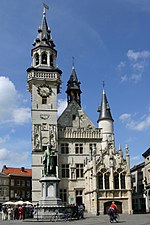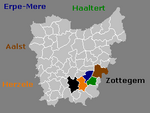Onze-Lieve-Vrouw van Meuleschettekapel
Chapels in BelgiumChurches in Belgium

Onze-Lieve-Vrouw van Meuleschettekapel, also known as The Meuleschettekapel, is a chapel in the Dirk Martensstraat in Aalst, Belgium. It was designed by Jules Goethals in 1894.
Excerpt from the Wikipedia article Onze-Lieve-Vrouw van Meuleschettekapel (License: CC BY-SA 3.0, Authors, Images).Onze-Lieve-Vrouw van Meuleschettekapel
Dirk Martensstraat,
Geographical coordinates (GPS) Address Nearby Places Show on map
Geographical coordinates (GPS)
| Latitude | Longitude |
|---|---|
| N 50.94076 ° | E 4.03098 ° |
Address
Dirk Martensstraat 101
9300 (Aalst)
East Flanders, Belgium
Open on Google Maps










